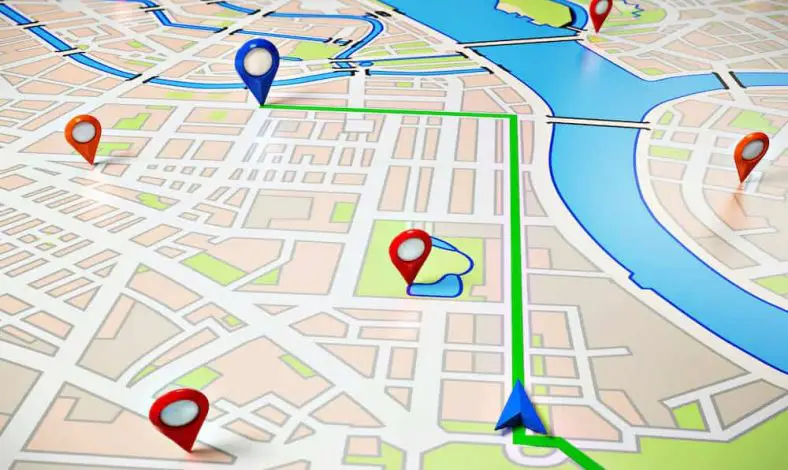How can you explain to a friend where you live? The easiest way to answer these questions is to open maps on your smartphone and drop a pin. Thanks to GPS, your phone maps will show the path in no time, 24/7, and charge-free. Let’s explore what GPS is and how it works.
GPS stands for the Global Positioning System. It consists of three main elements: satellites in space, ground-based control stations, and multiple receiver devices (phones, smartwatches, etc.).
GPS was developed in 1978 by the U.S. Department of Defense to track U.S. military ships. Meanwhile, civil airplanes and ships used radar or sonar navigation (involving electromagnetic and sound waves).
In the mid-20th century, an Inertial navigation system (INS) was invented, primarily for rockets and, soon, public transportation. However, these systems were far from accurate compared to GPS.
GPS went public because of the tragedy in 1983. That year, a Korean passenger jet crossed the USSR border after a navigation error and was shot down by the Soviet air defense. Thus, it became evident that GPS would help public services avoid similar incidents.
How does GPS work?
In 2022, 30 operational satellites are forming a “GPS constellation” 11000 miles away from the Earth. It seems like a small number, so you might wonder how satellites can give exact positions to millions of people at once. The satellite broadcasts coded radio signals at the speed of light, but it doesn’t make actual calculations. Devices, e.g., our phones, do all the processing. They get the assignment – they do the job. The mechanism is similar to the radio, which is available to anyone simultaneously, thanks to individual receivers.

The signal from the satellite contains data about its precise location at the exact time. The receiver calculates the distance differences to each satellite and thus gets its own position. Usually, the receiver needs signals from 4 satellites to make calculations.
With radiuses from two satellites, you are somewhere where these two “spheres” intersect. Thus comes the third satellite: the new intersection makes your position more precise. And finally, the fourth satellite is a fixing one: it resolved timing errors from all satellites to show your exact location.

GPS relies heavily on exact timing; that’s why every satellite has atomic clocks on its board – the most accurate timekeeping device.
Thanks to atomic clocks, GPS satellites are used to synchronize clocks to Universal Time (UTC). The satellites broadcast the signal with super high accuracy of ~30 nanoseconds.
🕰️ Wondering how the world agreed on time?
We’ve got you covered! Dive into the history of time zones and the inventions that made modern timekeeping possible. Explore the full article
The accuracy of GPS satellites depends on different factors, like atmospheric conditions, the position of the satellite, the receiver’s quality, tall buildings, or trees on the way. For example, if all negative factors are excluded, our smartphones are accurate up to a 5 m (16 ft.) radius. GPS is not the only navigation system of today. Several countries, like China, India, Russia, and Japan, use their own systems, global or regional. But GPS is the most popular one used by more than 6,5 billion devices.
How do we use GPS in everyday life?
GPS-enabled devices are widely used for navigation, detecting stolen items, and tracking.
Navigation. GPS is our day-to-day companion that assists us in locating positions and finding the best roads. The system significantly boosted solo travel because people feel more secure exploring new places without the risk of being lost.
But there is more to GPS than that.
Sport. GPS-focused smart watches enable us to monitor our everyday activities, measure our steps and motivate us to do more exercise.
Emergency. The system is used in rescue situations: emergency crews can trace our current location when responding to a fire or medical emergency. For example, a British ambulance uses GPS to find the patient’s spot and allows them to keep navigating when offline. Also, tracking helps keep an eye on older people with dementia who may have difficulty finding their way back home. Their devices have special buttons that make calls for help.
Pets care. In recent years, GPS trackers for pets are growing in popularity: they can be microchipped or inserted into collars so that the owner can immediately find their pet’s whereabouts. The number of GPS pet trackers in Europe and North America reach 3.8 million in 2022.
Security. Thanks to GPS, we can insert trackers into our cars and monitor them if they are stolen. For artworks, GPS trackers provide an additional layer of protection. So, it’s easy to trace thieves.
Less obvious GPS usage
Did you know that GPS satellites help measure ground motion and predict tsunamis?
Weather. When the earthquakes start under the water, the vibrations go up to the surface and can reach the ionosphere (50 km/30 mi from the Earth). The Sun works hard there, and the solar radiation is super high. These vibrations start the reaction with the radiation and produce jostlings. GPS satellites have special devices to detect these jostlings and send the information to on-ground centers. Thus, we can get warnings about tsunamis when they are still in the ocean and ensure people are evacuated.
Animal attacks. GPS enables us not just to catch our pets but to run away from dangerous animals. Over the past few years, more than 50 white sharps have gotten GPS trackers, helping coast guards prevent shark attacks more effectively. If an animal swims close to the seashore, its tracker will show up on the radar and inform about danger.
Studies of marine wildlife. Some research organizations, e.g., the Pacific Whale Foundation, use GPS tracking to collect data about dolphins and whales. These devices allow scientists to observe animals’ group dynamics and behaviors in their natural habitat. This data is valuable for marine life discoveries far from the coast.
Driverless cars. GPS is widely used in cutting-edge technologies, like driverless cars. These vehicles use numerous navigating devices: sonars, radars, movement sensors, cameras, etc. GPS receivers help to geolocate cars and show their physical locations in space in real time. Also, driverless cars have a high need for precise and up-to-date information about street conditions.
Road art. Thanks to GPS, people make art by blending creativity with sports and technology. They use a territory (the city or countryside) as a giant canvas, where they “draw” with movements on a bicycle or by running. Everything they use is a GPS tracker, mapping software, and imagination.

Interested in more topics about modern technology? Find out how we take photos of space and how we know exactly what space looks like.

